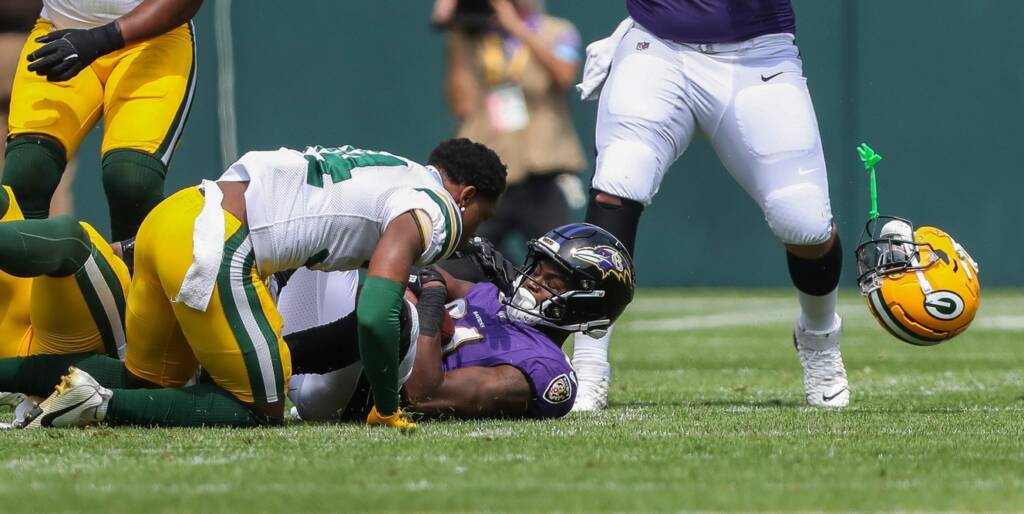
On Tuesday at 3 p.m. Central Time, the Green Bay Packers finalized their 53-man roster for the 2024 NFL season, as required by the league. As always, there were some surprising decisions, particularly at skill positions and in the secondary. Since becoming Green Bay’s general manager, Brian Gutekunst has drafted 72 players, with only eight failing to make the roster as rookies. This year, Kalen King and Michael Pratt joined that short list.
It wasn’t entirely unexpected that the Packers moved on from Pratt, but it’s noteworthy that they plan to bring back Sean Clifford to the practice squad. Although Pratt may be the better quarterback, Clifford’s two years in the system give him an edge. The Packers traded for Malik Willis on Monday, but he doesn’t represent a significant upgrade over Pratt. Given this, it might have been wiser to keep Clifford as the backup while developing Pratt as the third-string quarterback, rather than using a seventh-round pick on a player they ultimately released. Green Bay has a history of finding value in the seventh round, as seen with Rasheed Walker and Carrington Valentine.
Grant DuBose was also released, a tough decision considering it’s challenging to keep seven wide receivers on the roster, especially with two strong pass-catching tight ends. DuBose appeared to have a roster spot locked up for much of the preseason, which raised the possibility that Malik Heath might be cut instead. However, Heath remains on the team as the sixth receiver. DuBose, a talented NFL-caliber wide receiver, will likely find an opportunity with another team soon.
The Packers also cut ties with Royce Newman, Caleb Jones, Luke Tenuta, Lecitus Smith, and Donovan Jennings. Newman, who has struggled since entering the league in 2021, was a somewhat expected cut. The Packers kept 10 offensive linemen, but the swing tackle position remains a concern. The final roster includes Rasheed Walker, Zach Tom, Andre Dillard, Travis Glover, Kadeem Telfort, and Jordan Morgan. Morgan was poised to start at right guard before his injury, leaving Dillard, Glover, and Telfort as the primary swing tackle options. However, Glover is a rookie, Dillard has underperformed throughout his career, and Telfort has yet to play a snap in the NFL.
In the linebacker group, Kristian Welch was released, which wasn’t surprising given the depth at the position. Quay Walker and a healthy Edgerrin Cooper are set to start in Green Bay’s 4-2-5 scheme, even though Cooper missed much of the offseason program. Special teams contributors Eric Wilson and Isaiah McDuffie, who played under Jeff Hafley at Boston College, were retained. Additionally, third-round pick Ty’Ron Hopper was a lock to make the team, leaving no room for Welch.
The most surprising cuts occurred in the secondary, with Kalen King and Anthony Johnson Jr. being released. Johnson had an impressive showing in Green Bay’s preseason finale against the Baltimore Ravens, making plays all over the field. With Jeff Hafley’s strong track record in developing defensive backs, there was hope Johnson could thrive under his coaching.
Instead, Zayne Anderson made the team over Johnson, a move that has puzzled many Packers fans. Anderson, who has been almost invisible during training camp, preseason, and the regular season, secured his spot primarily due to his special teams contributions. However, Johnson was seen as the better developmental prospect.
Kalen King, who was once projected as a first-round pick in 2023, saw his stock plummet after opting to stay in college and experiencing a down year. The Packers took a chance on him in the seventh round, hoping he could rediscover his potential under Hafley’s guidance. Unfortunately, King’s release suggests that those hopes didn’t materialize.
This year, more “sure thing” predictions about who would make the team turned out to be wrong than usual. This discrepancy highlights the gap between fans’ and analysts’ perceptions and how the organization evaluates players. The Packers’ decisions reflect a different perspective on player performance and potential, underscoring just how difficult it is to predict roster moves based solely on preseason impressions.
Packers announce initial 2024 53-man roster.
— Green Bay Packers (@packers) August 27, 2024
Leave a Reply